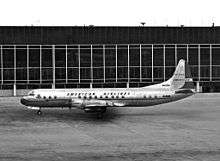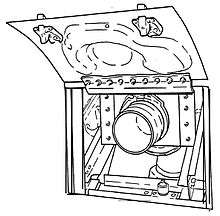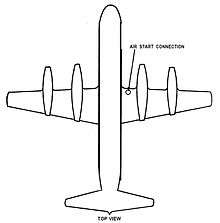Galaxy Airlines Flight 203
 The aircraft involved in the crash while still in operation with American Airlines as N6130A | |
| Accident | |
|---|---|
| Date | January 21, 1985 |
| Summary | Pilot/Ground Crew error |
| Site |
Reno, Nevada, United States 39°27′55″N 119°46′56″W / 39.465281°N 119.782223°WCoordinates: 39°27′55″N 119°46′56″W / 39.465281°N 119.782223°W |
| Aircraft | |
| Aircraft type | Lockheed L-188A Electra |
| Operator | Galaxy Airlines |
| Registration | N5532 |
| Flight origin | Reno-Cannon International Airport, Reno, Nevada |
| Destination | Minneapolis–Saint Paul International Airport, Minneapolis, Minnesota |
| Passengers | 65 |
| Crew | 6 |
| Fatalities | 70 |
| Injuries | 1 |
| Survivors | 1 (George Lamson Jr.) |
Galaxy Airlines Flight 203 was a Lockheed L-188 Electra 4-engine turboprop, registration N5532, operating as a non-scheduled charter flight from Reno, Nevada, to Minneapolis, Minnesota. The aircraft crashed in 1985 shortly after takeoff; all but one of the 71 on board died.
Flight chronology
The flight took off from runway 16R at Reno-Cannon International Airport (now Reno-Tahoe International Airport) at 1:04 am on January 21, 1985. A short time later, the aircraft crashed about 1.5 mi (2.4 km) from the end of the runway and burst into flames. It landed near a recreational vehicle dealership, and debris was scattered across US Highway 395 and South Virginia Street. Of the 71 people aboard, three survived the initial impact, but one of them died on January 29 and another on February 4. The lone survivor was then 17-year-old George Lamson Jr., who was thrown clear of the aircraft and landed upright, still in his seat, on South Virginia Street. (His father, George Lamson Sr., was one of the three initial survivors of the crash along with Robert Miggins but both later succumbed to their injuries in hospital.)
Truckee Meadows Fire Department was the first emergency response department to arrive at the scene of the crash. Several other Washoe County and State of Nevada agencies also responded. George Kitchen, who was a fire captain in the Reno Fire Department leading a crew from station No. 6 in south Reno, noted, "One of the first things we saw was the boy. He was still strapped in his seat out on South Virginia Street. He was conscious. We gave him first aid until the medics got there." Lamson gave an interview shortly after the crash in which he stated that he was able to walk away from his seat prior to the aircraft exploding. Lamson's testimony is substantiated by the owner of the Magic Carpet Mini Golf Course, who witnessed the crash and called in to emergency services. He states the boy was up and walking before the arrival of emergency services. The owner reported it took longer for the fire department to get there because they did not believe his call reporting a plane crash.[1][2]
A store and seven RVs were also damaged. The aircraft was returning from a gaming/Super Bowl trip sponsored by Caesars Tahoe.
Heavy vibration started shortly after takeoff, and the cockpit voice recorders recorded one of the pilots asking the tower to allow them to make a left downwind turn, and that they had to get back on the ground.
Due to a lack of facilities for handling so many bodies at once, the victims were taken to the Reno Livestock Events Center for autopsy and identification processes. The autopsies were led by the Washoe County Coroner, V. McCarty, and four medical students from the University of Nevada, Reno.
Investigation


The United States National Transportation Safety Board investigated the accident, and issued the following probable cause:
The National Transportation Safety Board determines that the probable cause of this accident was the captain’s failure to control and the copilot’s failure to monitor the flight path and airspeed of the aircraft. This breakdown in crew coordination followed the onset of unexpected vibration shortly after takeoff.
The NTSB added the following Contributing Factor:
Contributing to the accident was the failure of ground handlers to properly close an air start access door, which led to the vibration.
The NTSB report indicates that the ground handlers did not properly close the air start access door due to a sudden change in their procedure when the ground handler supervisor realized that the headset being used to communicate with the flightcrew was nonfunctional, and had to revert mid-routine to using hand signals. This break in routine led the supervisor to signal the flight to taxi before the air start hose was disconnected. Although he then realized that the hose was still connected and signaled the flight crew for an emergency stop, and the hose was successfully disconnected, the closing of the air start access door was not completed either prior to the supervisor's initial go-ahead or after the emergency stop.
The report concluded that the open air start access door led to vibrations that distracted the flight crew. The investigation indicated that these vibrations were not a threat to the aircraft's safe operation, and would likely not have prevented the aircraft from reaching cruise speed and altitude. Similar reports surfaced from other Electra pilots which indicated that the vibrations ceased at higher air speeds.
While the flight crew was trying to determine the source of the vibrations, they reduced power to all four engines simultaneously, presumably to test the engines to see if they were the source. Power was then not increased before the wings stalled.
The aircraft had been chartered to transport U.S. presidential candidates John Glenn and Jesse Jackson periodically in 1983 and 1984. On one flight with Jackson and his entourage between Washington, D.C., and Dallas, Texas, in May 1984, the aircraft shook, dropped and pitched due to heavy turbulence, reportedly resulting in a stewardess screaming and vomiting.[1] The United States Secret Service asked the Federal Aviation Administration to examine the aircraft, but nothing was found wrong.[1]
Aftermath
In April 1985, Lamson, Jr. returned to Reno to testify about the crash at the National Transportation Safety Board hearing. He told the Reno Gazette-Journal at the time, "I feel I was watched over for sure. I feel lucky to be alive."
A memorial called Galaxy Grove was dedicated at Rancho San Rafael in 1986. After the plaque was stolen in 2013, The Washoe County Parks Department commissioned a two-ton granite replacement. Lamson did not attend the dedication, feeling that it would be too difficult for him.[3]
In popular culture
Sole Survivor, a 2013 documentary by Ky Dickens, follows Lamson's story and challenges living with survivor's guilt along with the lone survivors of other plane crashes around the world.
See also
References
- 1 2 3 Magnuson, Ed; Kane, Joseph J.; Mathison, Dirk (February 4, 1985). "Crash of a Troubled Bird". TIME.
- ↑ Costantini, Allen (2005). "The Legacy of Galaxy Flight 203". kare11.org.
- ↑ Memories still raw for sole survivor of '85 plane crash, Guy Clifton, Reno Gazette-Journal, January 20, 2015, retrieved September 15, 2016.
External links
- Accident description at the Aviation Safety Network
- NTSB report
- Plane Crashes Since 1970 with a Sole Survivor at airsafe.com.